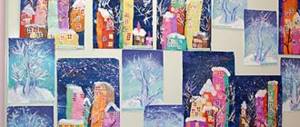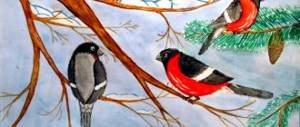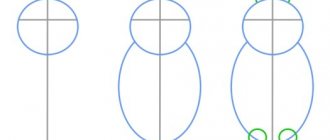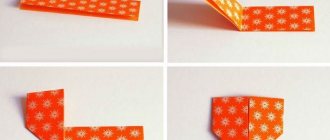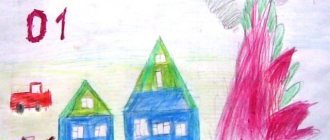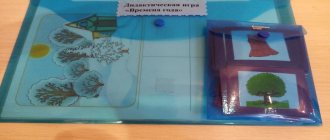How to teach children traffic rules?
In kindergarten there is a whole range of activities for children based on traffic rules. In particular, when planning educational activities to study traffic lights, I use the following methods and techniques:
- Conversations about the history of the traffic light, the significance of this invention for humanity and its safety. By the way, there is an excellent guide on this topic: “The History of Traffic Lights. Visual and didactic aid for classes with children 4-7 years old.” This manual was compiled specifically for the implementation of the “From Birth to School” program. There are 8 cards with comprehensive information about the traffic controller;
- Game activities: role-playing, active, didactic, board games. This is the most effective way for children to learn the most important and serious information. Role-playing games with real-life situations on the roads are especially good. For this purpose, you will need the “Traffic Light” costume, which you can buy at UchMag. In addition, I can recommend the cool board game “Traffic Light”;
- Competitions within the framework of a week or month on traffic rules, meetings with state traffic inspectors, excursions, observation during walks;
- Thematic classes: drawing, sculpting, gluing compositions on the topic of road traffic;
- Project activities: we study the history of traffic lights, make crafts, drawings, an exhibition, prepare a panel for parents, design a thematic corner. I liked this cut-out poster “Traffic Light” - it will decorate the traffic rules corner;
- Consultations are required for parents of preschoolers, since only in interaction with the family can the maximum effectiveness of teaching vital rules be achieved. I found the “Road Safety” memo useful for consultation; it contains useful information on how to study traffic light signals with children.
What should you remember when teaching traffic rules to preschoolers?
Children have such characteristics, psychological, physiological, psychosomatic, that require a special approach to teaching correct behavior on the road. So, when studying a traffic light, it is worth remembering that children in the younger group can firmly remember only 2-3 bright signs of any phenomenon or object. This means that they will be able to imprint the colors of the electronic traffic controller in their memory. In the first junior class we study red and green traffic lights, or rather, their colors.
In the second youngest we already remember all three colors. Children in the middle group, in addition to these three signs - the three colors of the traffic light - will remember that they light up in turn and indicate a command for transport and pedestrians. And older children can already easily navigate the colors and commands of traffic lights, and will also be able to tell a little about the history and meaning of this road device.
In addition, it is important to take into account that children under 8 years old cannot clearly and correctly identify sources of noise, and do not pick up all the sounds that the street is saturated with. Have you noticed that a child like you sometimes cannot hear? You call a hundred times, but he doesn’t even listen. The fact is that children pick up sounds that interest them. And his mother’s screams do not interest him. Therefore, when studying traffic rules, it is necessary to work with pictures in order to use visual memory and perception.
Also, the field of vision of children is much narrower than that of adults; six-year-olds, for example, have a view within a radius of 5 meters, no more. A clear understanding of right and left comes at the age of 7. All this is important to remember and not to demand the impossible from preschoolers. It’s not about knowledge or trust in the child, but about his capabilities.
Therefore, no matter how well a child knows the rules of behavior on the road, due to his age he cannot feel confident on the streets with this crazy traffic. And to learn the rules, you don’t have to drive to crossroads; this can be done easily and entertainingly in a group and at home.
Master class with watercolors
Tools and materials:
- Drawing paper (not glossy, thick).
- Simple pencil (TM).
- An eraser.
- Watercolor of primary colors.
- White gouache or white wax crayon (optional).
- Brushes (thin and medium thickness).
- Palette.
Progress:
Drawing a traffic light for children is always not only creativity, but also knowledge about life in the city. At the beginning of the lesson, you need to repeat the purpose of the traffic light, consider the difference between a traffic light for transport and pedestrians, and pay attention to the different ways of attaching traffic lights. Children will have to draw a hanging traffic light, but if desired, it can also be depicted on a stand.
Before drawing, it is advisable to consider different projection options using any small parallelepiped (for example, a box, boxes or a Lego cube). Using a specific example, children will see that when viewed from the side, two walls of the traffic light are visible, but if viewed from below, the bottom will be visible. When drawing, you can copy a sample or experiment with projections; this may be interesting for children over 7-8 years old.
A traffic light drawing for children is suitable both for introducing watercolors and for practicing skills. The difficulty of painting depends on the level of the students (for beginners, you can not focus on halftones).
Drawing is based on this plan:
- At the first stage, the dimensions and location of the traffic light are outlined with a simple pencil, and the wire and trapezoid of the housing are depicted. It is necessary to draw children's attention to the fact that the traffic light is deliberately made wider at the top than at the base, drawing attention to the burning red signal. This is an artistic design. You can not violate the rules of projection and draw a more realistic traffic light, taking the initial view from below or from the side.
- Next, draw the details with a pencil. Draw the side edge at an angle. Then signal lights are depicted. In accordance with the design of the design, the lights are lined up from largest to smallest one after the other with a slight offset to the right edge, as if they are being viewed from above. It is difficult for children to correctly track the change in size, so it is better to make three templates or select three round caps of different diameters.
- Next, a visor consisting of a wave and a semicircle is made above each signal.
- Then they erase the auxiliary lines and carefully remove all the crumbs from the gum.
- At the next stage, paint of any blue shade is laid out on the palette and a sufficient amount of water is added. The color should not be very bright. Next, use light strokes of a wide brush to paint over the background around the traffic light, without affecting the area around the red signal. The strokes are made in the direction from the silhouette of the traffic light. Then take a little red paint, dilute it heavily with water and tint the area around the red signal, simulating a glow. With a damp brush you can correct the smooth transition at the junction of two colors.
- Next, you need to wait 3-5 minutes for the background to dry. At this point you need to mix the colors for the traffic light body. Lay out the background color on the palette and add just a little black paint to it. Using a medium-thick brush, tint the front edge of the traffic light without touching the signal lights.
- Then more black paint is added to the background color and the side edge and visors are painted over. The top of the visor should be lighter. To emphasize this, you can run a damp, dry brush over this area several times. The inside of the visor can be painted with black paint.
- When the background has dried a little, start painting the signal lights. They should have light highlights in two places. This effect can be achieved in several ways: The classic approach for watercolors is to simply leave the highlights unpainted; for children this is a rather difficult task. You can also move a wet brush over the painted circle several times, but this technique allows you to make the color not so bright, but does not work well in spot application. Another option, which is easiest for children, is to apply highlights with white gouache on top. You can also draw highlights in advance with white wax chalk or pastels and paint over the top with watercolors, the chalk will show through the paint.
- When the image dries a little, the main lines are outlined with strokes of black paint. To do this, apply watercolor to a thin brush. Don't add a lot of water. Lines can overlap each other. There is no need for clarity as the black paint imitates pencil strokes.
A watercolor drawing of a traffic light can be an ideal option for children to practice different brush techniques and mixing paints.
Let's play traffic light!
The most effective method for studying traffic lights is outdoor games. Theoretical knowledge is important, but it is dead without practice. Until a child automatically learns the rule of standing when the traffic light is red and walking when the traffic light is green, there will be no sense in reading books, conversations, watching thematic pictures and cartoons.
A simple game “Stop! Go! will help you firmly understand traffic light signals and remember the actions of a pedestrian. The essence of the game is this: you need to simulate the situation at pedestrian crossings. Children in the younger group train to distinguish colors and traffic lights, while older children perform more complex attention tasks.
For example, children walk, run around the room, the leader shows a red flag or turns on a red light at a special training traffic light - the children must stop. Turns green - movement resumes. The game is complicated by additional attributes: transport, strollers with dolls, a road intersection is simulated, you can involve a traffic controller, a policeman, and divide children into pedestrians and drivers.
The movement of a train also brings excitement to the game, when children move holding hands or holding a rope, and the first in the column is the driver of the train. These games can be played indoors and outdoors. It is important to develop a reflex: red - stop, yellow - attention, green - go.
And most importantly, it is a daily example for parents and all adults of how to behave on the street. Until adults stop crossing the road on red in front of their children and together with them, running in front of cars, ignoring the danger, we will not be able to reduce child injuries and deaths on the roads.
Enough information for today, see you tomorrow! Write, share links, subscribe to news, be active!
Sincerely, Tatyana Sukhikh! Till tomorrow!
By the way, I recommend reading:
Abstract of OOD on drawing “Traffic light is our friend” in the middle group
Abstract of OOD on drawing “Traffic light is our friend” in the middle group
Goal: creating a social situation of development in the process of artistic and aesthetic development.
Tasks:
1. Consolidate knowledge about the operation of traffic lights and the rules for crossing the street.
2. Strengthen the ability to work correctly with pencils, select colors, carefully paint over parts of a traffic light without going beyond the outline of the drawing. Reinforce your knowledge of primary colors.
3. Cultivate accuracy, patience, and the ability to complete a task.
Materials: picture of a traffic light, watercolor paints, brushes, sippy cups, oilcloths
Progress of the lesson:
Educator: Guys! Guess the riddle and find out who came to visit us!
To help us pass the dangerous path,
Lights up day and night green, yellow, red.
What it is? That's right, it's a traffic light! Look, this is what we have. How many colors are there in it? (three, red, yellow and green) What does red mean, and what does yellow mean, and what does green mean? (children's answers) Guys, tell me, why do we need a traffic light? (children's answers) Is there a traffic light everywhere where you can cross the road? (you can cross a zebra crossing) Do you know that there are traffic lights for pedestrians and others for drivers? How are they different? For pedestrians, the traffic lights have two signal colors, green and red, and for drivers, there are three (red, yellow and green). And pedestrians at the traffic lights also have images, do you know which ones?
Problematic issues:
-What is shown in the picture?
-Which traffic light signal is shown?
-How do drivers react to a red (yellow, green) traffic light?
-How do pedestrians react to traffic lights?
-What is a traffic light for?
-Is it possible to cross a road next to which there is no traffic light?
-Why should both drivers and pedestrians know traffic light rules?
Physical education minute
The guard stands stubborn (Walking in place).
He waves to people: Don't go! (Move your arms to the sides, up, to the sides, down)
Here the cars drive straight (Hands in front of you)
Pedestrian, you wait (Hands to the sides)
Look: smiled (Hands on belt, smile)
Invites us to go (We walk in place)
You machines, don't rush (Hand clapping)
Let the pedestrian pass! (Jumping in place)
Educator: And now you and I will also draw our own traffic light! For a traffic light to work correctly, you need to arrange the colors in the correct order. First we have red, then yellow and then green. After changing the color, be sure to blot the brush in some water!
Conclusions: What kind of traffic lights you made! Remind me what we talked about in class? Why do we need a traffic light?
